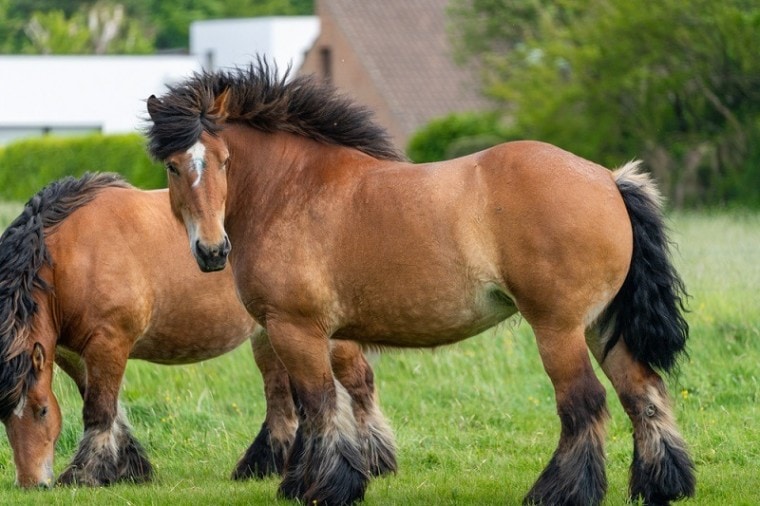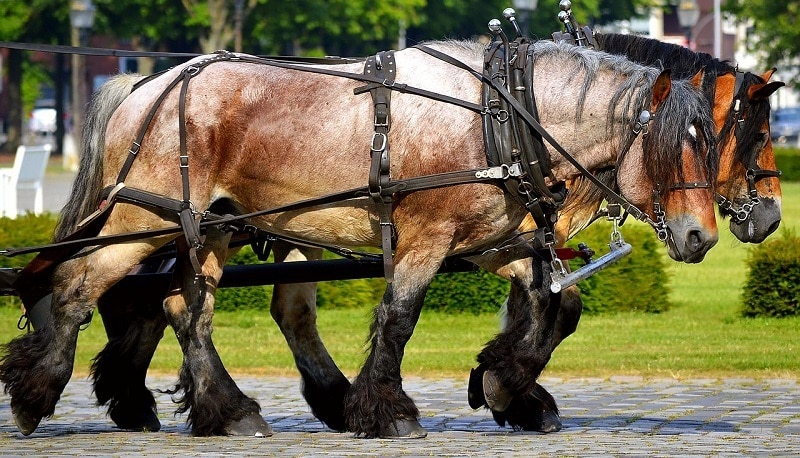
Click to Skip Ahead
The Ardennes horse is an ancient European draft horse that has been bred for over 2,000 years in the Ardennes region. They are kind, calm, and docile horses with broad and muscular bodies with short, stout legs, making them perfect for draft work, especially given their high stamina and strength. Even Julius Caesar deemed them hard-working, tireless, and rustic.
Let’s learn more about the muscular, even-tempered Ardennes horse.
Breed Overview
| Care Level | Moderate |
| Temperature | Cold climates, harsh winters, hilly and rough terrain |
| Temperament | Gentle, easy-going, docile, calm |
| Colors | Chestnut, bay, roan, gray, palomino |
| Lifespan | Roughly 31 years |
| Weight | 1,500–2,200 lbs (stallions), 1,500–2,200 lbs (mares) |
| Height | 16 hands (stallions), 15.3 hands (mares) |
The Ardennes horse is a large horse breed named after its place of origin, which is the Ardennes region of France, Belgium, and Luxembourg. These horses are used mainly for draft work and are considered the oldest breed of draft horses in the world.
The bloodline dates back to Rome but has changed over the years. These horses are heavy-boned but of short stature, and they have been crossbred with many different breeds to make them even bigger and stronger. Today, the Ardennes horse is heavily impacted by the Belgium breed, which the Ardennes horse shares many genes with.
These horses have served as the bloodstock foundation of other useful draft horses, as well as other equine breeds, including the Baltic Ardennes, Swedish Ardennes, Russian Heavy Draft, Sokolsky, and the Trait Du Nord.
Ardennes Horse Characteristics
What Are Ardennes Horses Used For?
These horses are used for meat production, as well as competitive driving, therapeutic horseback riding, draft work, and farm and leisure work. They are extremely useful given their size, which is excellent for pulling, and their ability to withstand harsh, cold climates and rugged, mountainous terrain is also useful.
Napoleon used Ardennes horses to pull artillery and transport supplies during the 1812 Russian campaign. These horses were the only breed at the time that could withstand the harsh winter climate in Moscow. They were also used by Marshal Turenne as remounts for his cavalry. In fact, they were considered the best artillery horses available during the French Revolution due to their strength, stamina, and temperament.
They were used during World War I for pulling artillery, and the Belgium and French armies heavily depended on the breed for such use.
Where Did The Ardennes Horses Originate From?
Ardennes draft horses are believed to have descended from the ancient Solutre horses, which roamed the Saone, Meuse, and Rhone river basins during the Paleolithic period, circa 50,000 BC. Julius Caesar deemed these horses tireless, rustic, and hard-working animals in his first-hand account called “Comentarii de Bello Gallico,” as these horses proved useful during wartime with their enormous legs and pulling power.
Temperament & Intelligence of the Ardennes Horse
These horses are gentle and people-oriented. They are docile, well-mannered, and learn quickly. Their gentle nature and usefulness for draft farming make them a favorite with beginners and experienced horse owners alike. They also have high stamina and strength, and their ability to roam rough terrain in mountainous regions makes them extremely beneficial.
The intelligence level of the Ardennes horse made them popular war horses and, later, for performing agricultural work, such as pulling wagons. These horses are kind, calm, tolerant, and patient. One would think that their massive stoutness would be hard to handle, but they are anything but—even children can easily train and handle these horses, especially given their short stature.
Appearance & Varieties

The Ardennes horse comes in a variety of colors, such as chestnut, bay, roan, gray, and palomino, with bay and roan being the most common colors. You may run across black Ardennes, but they are rare and not included in the breed confirmation.
These horses are broad and muscular, with extremely muscular legs and a compact body. The face is broad with small, pointed ears, and they have a small back, strong joints, and feathered fetlocks. They are heavily boned and wide with small feet. They have minimal white markings that are typically restricted to a star or blaze.
These easy keepers mature early and are widely used for competitive driving and draught event shows today.
Things to Know When Owning an Ardennes Horse:
Habitat & Stable Requirements 🌾
The Ardennes horse’s habitat is mountainous terrain and harsh, cold climates, and they are not sensitive to extreme weather conditions, which makes them exceptionally resourceful. The population to date is not completely known; however, in France, there were roughly 145 breeders and 511 broodmares in 2010, and it is believed the numbers are similar in other countries with no significant increase or decrease. They are distributed across Belgium, Luxembourg, and France.
They require shelter and frequent turnouts; however, due to their hardiness in cold, harsh climates, they can live in a pasture with a run-in shed or be kept in a regular stall inside a barn.
Food & Diet Requirements 🥕
These horses require a diet of hay, grains, and grass, making them less expensive horses to own. The Ardennes horse is also known as an economic animal to feed without breaking the bank. Depending on the hay and grass’s nutritional content, they may need additional mineral supplements and vitamins, which an equine veterinarian can determine if need be.
Exercise 🐎
These horses are hard-working and need a job to do with regular exercise to keep them healthy. Agricultural work and logging are ideal, as well as using them for therapeutic horseback riding. They also require a large pasture for turnouts to run and receive daily exercise.

Training 🐴
The Ardennes horse is docile, calm, well-mannered, and easy to train. They are considered gentle giants and love people, and they possess a high level of patience, intelligence, and common sense, which contributes to their ease of training.
Grooming 🧽
Grooming is an excellent bonding opportunity with horses, and you should groom your Ardennes horse daily. Grooming also allows for a daily check-in on their overall health, such as finding abnormalities that need addressing. The mane and tail need delicate grooming due to the thickness, and those areas should be picked through gently to avoid breakage.
The hooves should be cleaned daily, as well as their feathered fetlocks. A caretaker should “pick” the feet to remove manure and dirt to prevent possible infections, as well as check for odors, bruising, or discoloration. Trim the hooves every 6–8 weeks to maintain normal growth.
Lifespan & Health Conditions 🏥
These horses do not have many health conditions they are predisposed to; however, they may develop skin infections due to bacteria getting into the feathered fetlocks. They also may develop sidebone, a common hereditary condition seen in draft horses where the cartilage in the coffin bone (located in each of their hooves) hardens and turns into bone.
Male vs Female
There’s no real difference between males and females in terms of weight, as both males and females weigh between 1,500–2,220 pounds. Males are slightly taller, with an estimated height of 16 hands compared to 15.3 hands in a female.
Some believe stallions have more personality than mares, but this may not always be the case. Some horse owners also prefer geldings over mares because they tend to be calmer and even-tempered. Geldings tend to be less aggressive with their owners as opposed to stallions.
Male horses are typically stronger and faster than females, and males do not tire as easily as females on long rides. Females are less aggressive, independent, more docile, and easier to train.
3 Little-Known Facts About the Ardennes Horse
1. Their Abundance of Hair Keeps Them Warm
We’ve discussed that these horses can handle harsh, cold climates, and the reason is all the hair they possess. The mane and coat are thick, as well as their coat, which shields them from frigid temps.
2. Black Is a Rare Coat Color
It’s rare to find a black Ardennes horse, and the most common colors are roan and bay. You can also find them with gray, chestnut, and palomino coat colors.
3. They Are Still Used for Work Today
Despite a decline in population after World War II, these horses have gained popularity in modern society as excellent workers for farm, forestry, and leisure work. A bonus with these horses is the ease of training and how economically resourceful they are, requiring a diet of only hay, grass, and grains.
 Final Thoughts
Final Thoughts
Ardennes horses are an excellent choice for small-scale farming due to their ability to pull, enabling a small-scale farmer to use these horses for agriculture rather than heavy machinery. These horses are reliable and hardy and not susceptible to disease—only minor skin infections due to bacteria that can get trapped in their feathered fetlocks.
The Ardennes horse has a long history dating back to 50,000 BC. They make great workers on small farms and are docile and easy to train. These intelligent horses are well-mannered, easy to manage, and economically resourceful. Ardennes horses are considered gentle giants and are suitable for first-time horse owners and experienced owners, and they are excellent for therapeutic horseback riding.
Featured Image Credit: Olga_i, Shutterstock


 Final Thoughts
Final Thoughts





